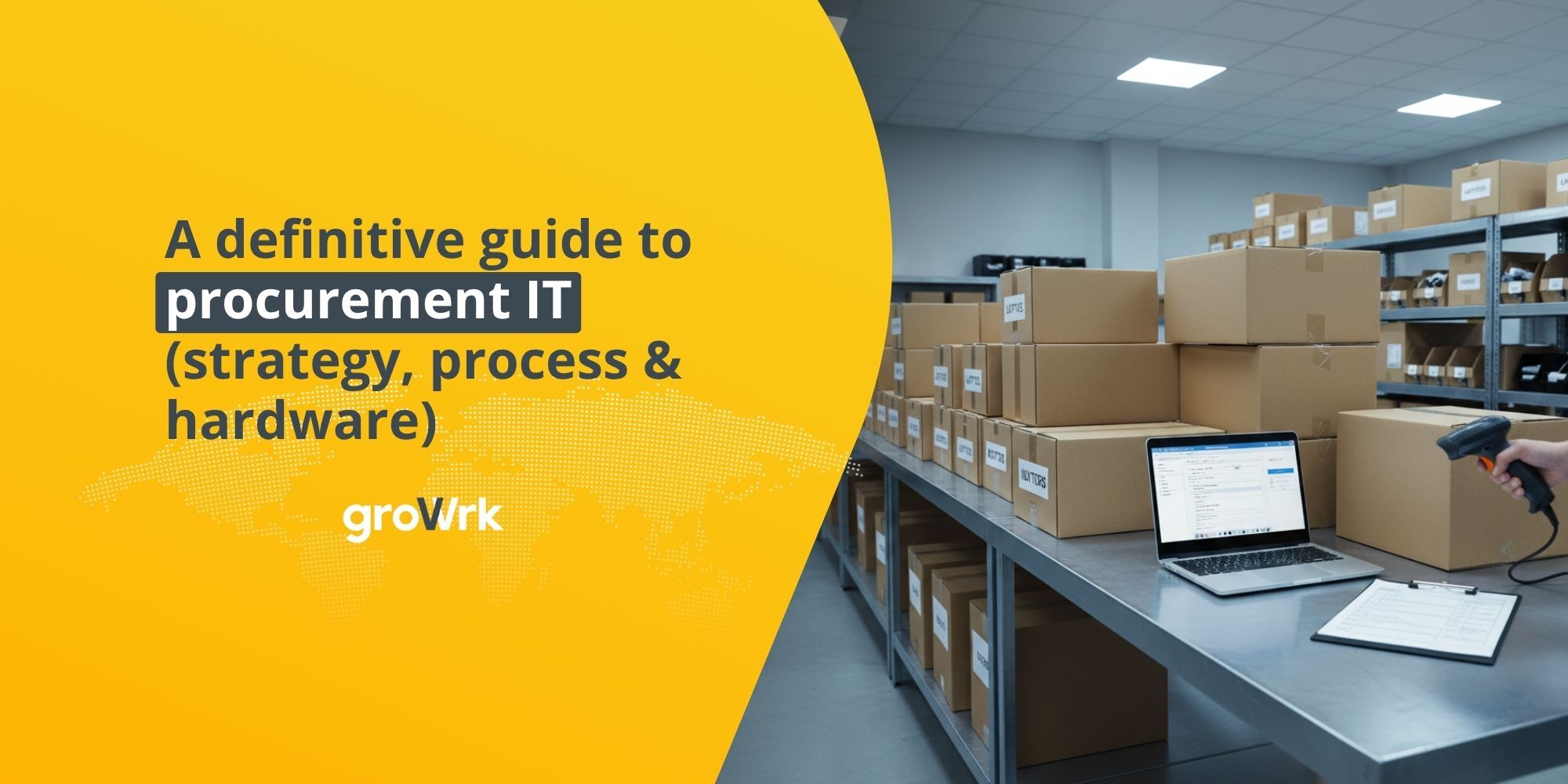The essential and quick IT audit checklist for small businesses
 GroWrk Team
GroWrk Team
Worried about your small business’s IT security and compliance? This internal audit checklist for small businesses will guide you to secure your IT systems, stay compliant, and enhance performance. Discover the essential steps and key components of an effective IT audit.
Key takeaways
-
IT audits are essential for small businesses to identify vulnerabilities, ensure compliance, and improve operational efficiency across their IT environments.
-
Key components of an IT audit checklist include physical security controls, data security measures, access management, regulatory compliance, disaster recovery, and performance metrics tracking.
-
Regular audits and continuous documentation of findings promote ongoing improvement in security practices, helping small businesses stay compliant with regulations and secure from threats.
-
An internal audit checklist is crucial for establishing a structured approach to IT audits, ensuring thorough assessments of IT infrastructure and compliance.
What are IT audits?

An IT audit is a systematic evaluation of an organization’s IT environment. Its primary purpose is to ensure data and network safety from attacks. An audit covers all aspects of information systems, management issues, security architecture, systems, networks, and physical security.
Regular IT audits help businesses uncover security risks, ensure IT asset management and security, identify vulnerabilities and comply with industry regulations. These audits also lead to recommendations for improving system performance and data management strategies, contributing to overall operational efficiency.
IT audits involve reviewing the IT infrastructure for outdated software, unauthorized devices, and necessary security patches. Key components include network security, system performance, and compliance with relevant standards and regulations.
How to make an IT audit? step-by-step process
The IT audit process is a systematic and structured approach to evaluating an organization’s IT systems, infrastructure, and practices. This process typically involves several key steps to ensure a thorough assessment:
-
Planning: The first step is to define the audit's scope, objectives, and timeline. This involves identifying the specific areas to be audited, setting clear goals, and establishing a schedule that minimizes disruptions to business operations.
-
Risk Assessment: Next, auditors identify potential risks and vulnerabilities within the IT systems and infrastructure. This proactive step helps prioritize areas that require immediate attention and ensures that the audit focuses on the most critical aspects of the IT environment.
-
Audit Procedures: During this phase, auditors conduct interviews, inspect evidence, and test controls to evaluate the effectiveness of IT systems and processes. This hands-on approach helps uncover weaknesses and areas for improvement.
-
Reporting: Auditors compile their findings and recommendations into a comprehensive audit report after gathering and analyzing data. This document outlines identified vulnerabilities and strengths and suggests corrective actions, providing a clear roadmap for enhancing IT security and compliance.
-
Follow-up: The final step involves implementing the recommended corrective actions and monitoring progress. This ensures the organization addresses the identified issues and continuously improves its IT systems and practices.
The essential and quick IT audit checklist
.png?width=600&height=300&name=it%20audit%20checklist%20for%20small%20business%20(1).png)
An IT audit checklist is a comprehensive guide for evaluating systems for security, compliance, and efficiency. It typically encompasses key areas such as system security, standards and procedures, documentation and reporting, and performance monitoring.
To provide a detailed understanding, we’ll break down the key components of an IT audit checklist into the following subsections:
-
Physical security controls
-
Data security measures
-
Access management
-
Regulatory compliance requirements
-
Disaster recovery and data backup
-
Network infrastructure assessment
-
Performance metrics tracking
-
Audit findings report
-
Continuous improvement documentation
Physical security controls
.png?width=600&height=300&name=it%20audit%20checklist%20for%20small%20business%20(2).png)
Physical security is crucial for IT audits, protecting against theft, outages, and data loss. Securing physical resources such as data centers and server rooms is vital for maintaining the integrity of the IT infrastructure.
Key physical security measures include restricted access, surveillance systems, and environmental controls to safeguard IT assets against unauthorized access and physical threats.
Regular audits reinforce these security measures, making access controls and protocols robust against threats. Testing data backups and physical security controls is essential in preparing against physical threats.
Adequate physical security controls include security badges, locks on server rooms, and surveillance cameras.
Data security measures
.png?width=600&height=300&name=it%20audit%20checklist%20for%20small%20business%20(3).png)
Data security is a cornerstone of the audit process, focusing on protecting sensitive data from breaches and unauthorized access. Key security controls include firewalls, antivirus software, encryption protocols, and access management systems.
Antivirus software is critical in IT audits for detecting and removing viruses and malicious code. Performing full system scans at least once a week helps maintain data security. Routinely auditing encryption methods ensures sensitive data remains protected from unauthorized access.
Network intrusion detection systems (NIDS) monitor network traffic and alert IT services of potential attacks. Penetration testing can effectively audit these systems to verify their efficacy in detecting and responding to threats.
Access management
.png?width=600&height=300&name=it%20audit%20checklist%20for%20small%20business%20(4).png)
Access management is crucial for IT systems as it prevents unauthorized access to sensitive data and systems. Managing user accounts is an essential aspect of the audit process, as these accounts can be potential access points for hackers. Role-based user access controls restrict user access according to job roles, enhancing security protocols.
Removing account access from employees who have changed roles and deleting dormant user accounts are best practices for risk management. Strong password policies and regular password changes further enhance system security.
Regulatory compliance requirements
.png?width=600&height=300&name=it%20audit%20checklist%20for%20small%20business%20(5).png)
Regulatory compliance is vital for small businesses to avoid legal penalties and ensure ethical operations. Compliance audits help identify system vulnerabilities that may lead to security breaches or compliance issues.
Key regulations include the General Data Protection Regulation (GDPR), which mandates strict guidelines for managing personal data, and the Health Insurance Portability and Accountability Act (HIPAA), which requires safeguards for sensitive health information.
The Payment Card Industry Data Security Standard (PCI DSS) requires maintaining secure systems and regularly monitoring networks to protect cardholder data. Non-compliance with these regulations can result in severe penalties, such as fines up to €20 million or 4% of global annual revenue for GDPR violations.
Disaster recovery and data backup
.png?width=600&height=300&name=it%20audit%20checklist%20for%20small%20business%20(6).png)
A robust disaster recovery plan is critical for small businesses to adapt to unforeseen data loss and maintain operations. A solid backup and recovery strategy should incorporate defined objectives, such as a Recovery Time Objective (RTO), to ensure quick recovery.
Drills and simulated disaster scenarios familiarize teams with recovery procedures and responsibilities. Routine testing of data backups confirms their functionality and ensures data can be recovered as needed.
Network infrastructure assessment
.png?width=600&height=300&name=it%20audit%20checklist%20for%20small%20business%20(7).png)
The network infrastructure is the backbone of a business’s communication and internet access. Firewalls are crucial for filtering traffic and preventing unauthorized access, and they play a key role during IT audits. To ensure security, all network firewall rule base changes must be reviewed and tested before approval.
An IT audit should evaluate the reliability and security of client/server and telecommunications systems. Additionally, network outages are assessed by analyzing their frequency, duration, causes, and preventative measures.
Performance metrics tracking
.png?width=600&height=300&name=it%20audit%20checklist%20for%20small%20business%20(8).png)
Tracking performance metrics helps evaluate network performance and quickly identify issues. Metrics to track include CPU and RAM usage, bandwidth usage, and storage space.
Monitoring CPU and RAM usage can help detect security issues or system failures, ensuring operational efficiency. Regularly tracking these metrics provides valuable insights into IT system health and performance, enabling proactive management.
Continuous improvement documentation
.png?width=600&height=300&name=it%20audit%20checklist%20for%20small%20business%20(9).png)
Continuous improvement helps small businesses enhance their security and operational practices after IT audits. Audit findings offer opportunities for continuous improvement, and documenting improvements ensures that lessons learned from audits are applied in future assessments.
A structured approach to documentation and improvement efforts leads to better compliance and more resilient IT operations. This ongoing process helps small businesses avoid potential threats and adapt to regulatory changes.
IT audit tools and techniques
IT auditors employ various tools and techniques to thoroughly evaluate IT systems and infrastructure. These tools are essential for identifying vulnerabilities, ensuring compliance, and enhancing overall security:
-
Network scanning and vulnerability assessment tools: These tools help identify potential security vulnerabilities within the network. By scanning the network, auditors can detect weaknesses that cyber threats could exploit.
-
Penetration testing: This technique involves simulating cyber attacks to evaluate the effectiveness of security controls. It helps identify how well IT systems can withstand real-world attacks and highlights areas that need strengthening.
-
Data analytics tools: Analyzing large datasets with data analytics tools allows auditors to identify trends and anomalies. This helps uncover hidden issues and ensure robust and effective data management practices.
-
Compliance frameworks and standards: COBIT and NIST provide a structured approach to evaluating IT systems and processes against industry best practices. These standards help ensure that the organization’s IT environment meets regulatory requirements and follows established guidelines.
-
Audit software: Utilizing audit management platforms streamlines the audit process and improves efficiency. These platforms facilitate the organization, documentation, and tracking of audit activities, making the auditing process more manageable and effective.
IT audit best practices
To ensure effective IT audits, organizations should adhere to several best practices. These practices help in identifying and addressing potential risks and vulnerabilities, providing a robust and secure IT environment:
-
Conduct IT audits regularly: Regular IT audits are crucial for continuously identifying and mitigating risks. Organizations can avoid potential threats by consistently scheduling audits and maintaining compliance with industry standards.
-
Implementing a risk-based approach: Focusing on high-risk areas and processes ensures that the audit addresses the most critical aspects of the IT environment. This targeted approach helps allocate resources efficiently and prioritize efforts where they are needed most.
-
Using a combination of audit tools and techniques: Various tools and techniques are employed to evaluate IT systems and infrastructure comprehensively. This multifaceted approach helps uncover hidden vulnerabilities and ensure a thorough assessment.
-
Ensuring implementation and monitoring of audit findings: Acting on the findings and recommendations is essential. Implementing corrective actions and continuously monitoring progress ensures that identified issues are addressed and improvements are sustained.
-
Continuously updating and refining the audit process: The IT audit process should evolve to remain effective and efficient. Regularly updating audit methodologies and incorporating feedback from previous audits helps refine the process and its effectiveness.
Internal vs. External audits
.png?width=600&height=300&name=it%20audit%20checklist%20for%20small%20business%20(10).png)
The organization’s employees carry out internal audits to evaluate internal controls and internal audit risk management. An internal audit checklist is often used to ensure thorough evaluations and structured assessments of IT infrastructure and compliance.
Internal audits can be conducted more frequently, allowing flexibility to focus on particular areas of concern as needed.
External audits, performed by independent parties, offer an unbiased assessment of an organization’s systems and ensure compliance with industry standards and regulations.
|
Internal Audits |
External Audits |
|---|---|
|
Conducted by the organization’s employees |
Conducted by Independent parties |
|
More frequent, as needed |
Specific intervals, often annually |
|
Flexible, focuses on specific concerns |
Unbiased assessment of overall compliance |
|
Flexibility and frequent checks |
An unbiased, comprehensive evaluation |
Preparing your team for an IT audit
.png?width=600&height=300&name=it%20audit%20checklist%20for%20small%20business%20(11).png)
Preparing your team for an IT audit ensures a smooth and effective process. Identifying team members and understanding their roles and training is key. Communicating the audit’s purpose and scope aligns expectations between the organization and the audit team.
Orienting auditors about the organization can help them assess IT systems more accurately. Informing the IT department staff about their involvement with the audit also ensures cooperation and readiness.
How GroWrk can help small businesses?
.png?width=600&height=300&name=it%20audit%20checklist%20for%20small%20business%20(12).png)
GroWrk simplifies IT Asset Management for small businesses, ensuring seamless procurement, deployment, and maintenance of IT equipment—no matter where your team is. Companies can scale operations efficiently without logistical headaches with an AI-powered platform and global reach.
- End-to-end IT Asset Management: Automates procurement, deployment, retrieval, and secure disposal of IT equipment, reducing manual effort and optimizing resource use.
- Global coverage: Operates in 150+ countries, ensuring IT teams can store, retrieve, and deploy assets seamlessly across distributed teams.
- AI-powered IT support: Provides real-time troubleshooting and operational support, ensuring minimal downtime and fast issue resolution.
- Advanced IT asset monitoring: Offers instant visibility into IT inventory, device health, and asset performance, enabling better decision-making.
- Enhanced security and compliance: It integrates with MDM solutions, provides identity management, and enables remote control for stronger security.
- Personalized customer support: Includes a dedicated Customer Success Manager and AI-powered troubleshooting to ensure smooth IT operations.
Scale your business with seamless IT management. Schedule a demo with GroWrk today to simplify worldwide procurement, deployment, and asset tracking.
Frequently asked questions
What is the primary purpose of an IT audit?
The primary purpose of an IT audit is to ensure the safety of data and networks by identifying vulnerabilities, uncovering security risks, and maintaining compliance with industry regulations. This process is crucial for protecting organizational assets and mitigating potential threats.
What are the key components of an IT audit checklist?
An effective IT audit checklist should include physical security controls, data security measures, access management, compliance with regulations, disaster recovery plans, network assessments, performance metrics, audit findings reporting, and documentation for continuous improvement. Addressing these components will ensure a comprehensive audit process.
How do internal audits differ from external audits?
Internal audits are performed by an organization's personnel, allowing for frequent and focused assessments. In contrast, external audits involve independent parties providing impartial evaluations to ensure compliance with regulations. This distinction underlines the varying roles each type of audit plays in organizational oversight.
Why is it important to prepare your team for an IT audit?
Preparing your team for an IT audit ensures a smooth and effective process. Clear communication about the audit's purpose and involvement fosters cooperation and readiness among IT staff, ultimately leading to a successful outcome.
How can GroWrk help small businesses manage their IT infrastructure?
GroWrk helps small businesses manage their IT infrastructure effectively through AI-driven support, streamlined equipment processes, and advanced security features. This enables them to ensure security and compliance while maximizing resource efficiency.





